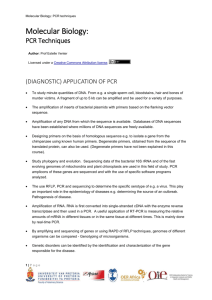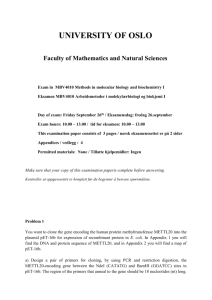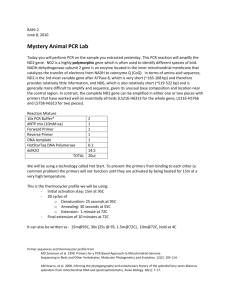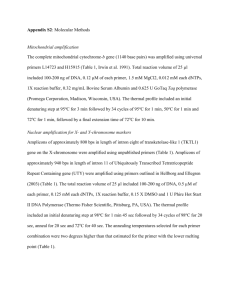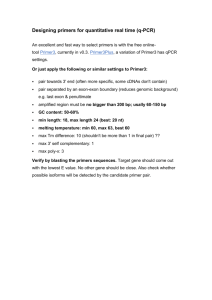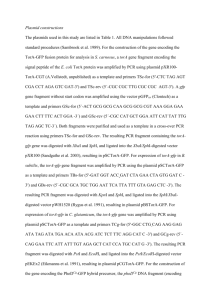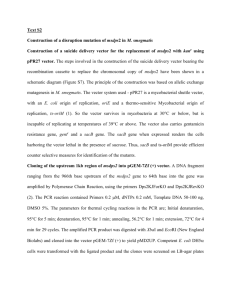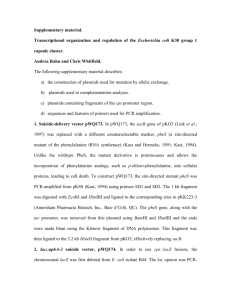Word file (32 KB )
advertisement
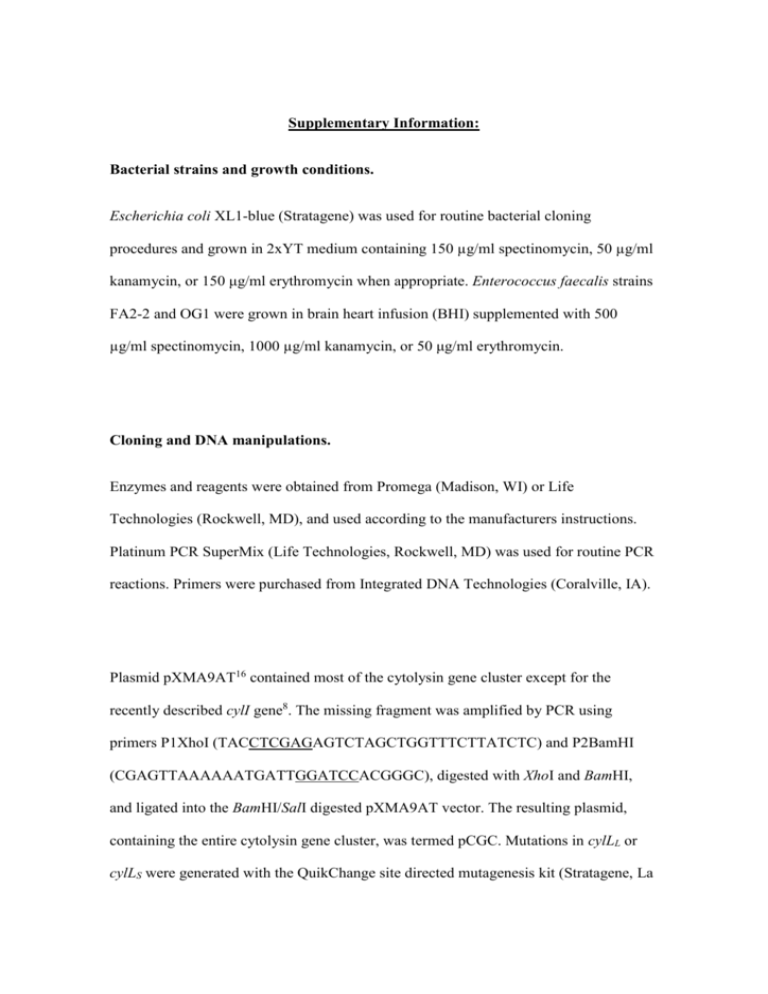
Supplementary Information: Bacterial strains and growth conditions. Escherichia coli XL1-blue (Stratagene) was used for routine bacterial cloning procedures and grown in 2xYT medium containing 150 µg/ml spectinomycin, 50 µg/ml kanamycin, or 150 μg/ml erythromycin when appropriate. Enterococcus faecalis strains FA2-2 and OG1 were grown in brain heart infusion (BHI) supplemented with 500 µg/ml spectinomycin, 1000 µg/ml kanamycin, or 50 μg/ml erythromycin. Cloning and DNA manipulations. Enzymes and reagents were obtained from Promega (Madison, WI) or Life Technologies (Rockwell, MD), and used according to the manufacturers instructions. Platinum PCR SuperMix (Life Technologies, Rockwell, MD) was used for routine PCR reactions. Primers were purchased from Integrated DNA Technologies (Coralville, IA). Plasmid pXMA9AT16 contained most of the cytolysin gene cluster except for the recently described cylI gene8. The missing fragment was amplified by PCR using primers P1XhoI (TACCTCGAGAGTCTAGCTGGTTTCTTATCTC) and P2BamHI (CGAGTTAAAAAATGATTGGATCCACGGGC), digested with XhoI and BamHI, and ligated into the BamHI/SalI digested pXMA9AT vector. The resulting plasmid, containing the entire cytolysin gene cluster, was termed pCGC. Mutations in cylLL or cylLS were generated with the QuikChange site directed mutagenesis kit (Stratagene, La Jolla, CA) using pCGC as a template. Primers cylLL-QCK-F (GGGTAAGAATTATGGAAAATTAAAGTGTATAACCTAGTTTTGAAGAACT) and cylLL-QCK-R (AGTTCTTCAAAACTAGGTTATACACTTTAATTTTCCATAATTCTTACCC) were designed to create premature stop-codons in cylLL, while primers cylLS-QCK-F (AGTGAGGTGAAGCACAGTGTAAAATAAGTAAAATCAAGAAAAC) and cylLSQCK-R (GTTTTCTTGATTTTACTTATTTTACACTGTGCTTCACCTCACT) generated stop-codons in cylLS. The two modified plasmids were designated pWH617 and pWH851, respectively. Strain FA2-2 (pWH705) was deficient for CylLL, nonhemolytic, and the source of CylLS” for Miller assays. Plasmid pWH705 was generated by PinAI digestion of pCGC, treatment with Mung Bean Nuclease, and religation, resulting in a frame-shift mutation in cylLL. Transcriptional fusions to a promoter-less lacZ gene were made in the shuttle vector pTCV-lac9. DNA was amplified by polymerase chain reaction which generated BamHI and EcoRI restriction sites for cloning in front of the lacZ gene. The following PCR primers were used: pLX100: CF493F-E (TTGAATTCCTCCTTTTTGTCAAG) and CF614R-B (CCATAATTCTTAGGATCCATCATAAAATTGTTG), pLX110: CFV1829R-E (AGAATTCGTTAGAAATGAAAGGC) and CF614R-B, pLX200: CF493F-B (TTTGGATCCTCCTTTTTGTCAAG) and CF614R-E (CCAGAATTCTTACCCTCCATCATA). A mutation in cylR1, pLX111, was generated by partial PCR amplification of the cylR1 gene in pLX110. Primer pair CFV1829R-E and ORF1-1072R-S (TTACTAGTTTTTTATTGGATATCATTTCTGTA) amplified 2 cylR2 and part of cylR1, while the two primers ORF1-1065F-S (AAACTAGTTAGCCATTTTGGTTCCTCC) and lacZ79R (GATTAAGTTGGGTAACGCC) amplified the remainder of cylR1, the PL promoter and part of lacZ. The two PCR products were digested with SpeI, ligated, digested with BamHI and EcoRI, and cloned into pTCV-lac. This procedure introduced not only a SpeI site near the start codon of cylR1, but also a frame shift mutation and a stop codon. A similar approach, using primers CFV1829R-E, ORF2-1395R-S (AAATGATAATCAAACTAGTAAAATTAATTAGAGAG), ORF2-1376F-S (TAACTAGTTGATTATCATTTATGAAGTCCTC) and lacZ79R, was used to generate pLX112, containing a mutation in cylR2. Plasmid pLX113 was the result of a spontaneous frame shift mutation in pLX111 that occurred in the cylR2 gene. All transcriptional lacZ fusions and mutants were verified by DNA sequencing. Reporter Gene Assay. Βeta-galactosidase reporter gene expression was measured according to Miller23 with modifications. E. faecalis FA2-2 cells containing transcriptional fusions to the lacZ gene in pTCV-lac were grown in 25 ml BHI containing 1,000 μg/ml kanamycin and 50 μg/ml erythromycin. After 13 hours at 37C the cultures were divided into two 10 ml aliquots A and B. Aliquot A was induced by adding 2.5 ml of sterile filtered culture supernatant from an overnight culture of the CylLS” producing strain FA2-2 (pWH705). Sterile culture supernatant (2.5 ml) from strain FA2-2 (pAT28) was added to aliquot B as negative, uninduced, control. Cultures were incubated for 3 hours at 37C, washed in 2 ml Z-buffer (60 mM Na2HPO4, 40 mM NaH2PO4, 10 mM KCl, 1 mM MgSO4, 50 3 mM -mercaptoethanol) and resuspended in 1.8 ml Z-buffer. Cells were disrupted for 60 sec at 5000 RPM in the presence of 0.5 ml zirconia beads (0.1 mm diameter) in a Mini-Beadbeater (Biospec Products, Bartlesville, OK). Five hundred μl of cleared cell lysate, diluted 1:10 or 1:50 in Z-buffer when necessary, was incubated with 100 μl ONitrophenyl-B-D-Galactopyranoside (Amresco, Solon, Ohio) substrate (4 mg/ml ONPG in 0.1M phosphate buffer, pH7.0). The reaction was stopped after 30 min at room temperature by adding 250 μl of 1M Na2CO3. The OD405 of 200 μl sample was read in a Thermomax microplate reader (Molecular Devices, Sunnyvale, CA). The protein concentration of 10 μl cleared cell lysate was determined with 200 μl Coomassie Plus Protein Assay Reagent (Pierce, Rockford, IL) according to the manufacturers instructions. The OD405 per mg protein was multiplied by ten and designated Miller units. Assays were repeated in four independent experiments. RNA quantitation. A culture of E. faecalis FA2-2 (pWH851) was grown to an OD562 of 0.5 and divided into twelve 30 ml aliquots. Ten, 1, 0.1 or 0 ml of sterile filtered culture supernatant from the CylLS” producing strain FA2-2 (pWH617) were added and the volume adjusted to 40 ml by adding the appropriate amount of FA2-2 (pAT28) sterile culture supernatant. RNA was isolated24 after incubation for 1 hour at 37C and quantitated as follows: Real-time quantitative PCR was used for transcriptional analysis of cylLS, cylLL, cylR1, and cylR2. Amplification, detection, and analysis were performed using the ABI Prism 7700 Sequence Detection System (SDS) (PE Biosystems, Foster City, CA). For 4 detection of amplified product, the SYBR Green I dye chemistry (PE Biosystems) was used. Specific primers for product amplification were designed based on the available sequence data for pAD121. Primers were designed to produce amplicons of equivalent length (100 base pairs). For each experimental reaction, cDNA synthesis and PCR amplification were performed separately on the SDS. Samples used in comparisons were normalized to one another using amplified product derived from the 23S rRNA of E. faecalis as an internal control, amplified in parallel. In each reverse transcription reaction, 10 ng was used to generate cDNA with the appropriate specific reverse primer and the TaqMan Reverse Transcription Reagents kit (PE Biosystems) according to the manufacturer's recommendations without further modifications. Five microliters from each reaction was used in subsequent PCR amplification with the appropriate forward and reverse primers and the SYBR Green PCR Master Mix kit (PE Biosystems) according to the manufacturer's recommendations. The following primer pairs (forward and reverse) were used: cylLS: GTAAAATAAGTAAAATCAAGAAAACTATTACTC and CAAAAGAAGGACCAACAAGTTCTAATT; cylLL: CTGTTGCGGCGACAGCT and CCACCAACCCAGCCACAA; cylR2: CCAAAGTGAATTAGCTGCTTTATTAGAA and TTAATGCTAACTGTAAAGAAGGGTTATATTTATT; cylR1: TTTATTTTTTTATTGGATATCATTTCTGTAGTC and TTCGCTCATCTTTTTTTGAATCAG; 23S rRNA: CCTATCGGCCTCGGCTTAG and AGCGAAAGACAGGTGAGAATCC. Additional controls were provided for each primer pair and each RNA sample by performing a cDNA synthesis reaction without 5 reverse transcriptase, followed by PCR amplification, to determine contamination of RNA samples by residual genomic DNA. The value used for comparison and quantitation among the samples was the threshold cycle (CT) determined by the SDS based on the incorporation of the SYBR Green I dye in the amplified product, subsequent fluorescence upon excitation, and normalization to a passive reference dye (ROX) included in each reaction. The CT value is defined as the cycle number at which the fluorescence exceeds a threshold identified by the SDS software. The threshold is set in the exponential phase of the PCR amplification during which there is a linear correlation between the log in the change of fluorescence and cycle number. Thus, the higher the initial amount of specific template in each reaction, the earlier accumulated product is detected by dye incorporation and fluorescence emission, and the lower the CT value. For each product, CT values from the different treatment groups were used to determine the levels of induction. Because each cycle of difference represents a doubling during the linear phase of amplification, the amount of induction relative to the sample with the lowest amount of template was calculated by the formula y=2X, where x is the difference in CT values and y is the relative change in gene expression. For each gene for which expression was investigated, real-time quantitative PCR analysis was performed using three independent RNA preparations from each of the treatment groups. Thus, expression data for each gene in each group is presented as the mean and standard deviation calculated from three independent amplifications with each primer pair. 6
